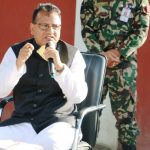Human trafficking is done for the purpose of exploitation which is illicit and it includes the sexual exploitation, involuntary labor or services, repression or practices like to slavery, servitude or the removal of organs. Human trafficking is a severe violation of human rights and a serious criminality. Every year, thousands of men, women and children unknowingly go into the hands of traffickers, either in their own countries or in foreign lands.
[quote_box_left]
Author
Janaki Kumari Sharma
[/quote_box_left]
Almost each country in the world is severely affected by trafficking either in the form of point or in the form of destination. According to the valuation of ILO nearly about 2.4 million people become victims of trafficking in the world every year. This is the very dreadful issue for all of us in the upcoming days as it is appearing into transforming faces with the pace of advanced technology.
Human trafficking particularly is mounting in the least developed countries like Nepal. In Nepal, annually, large number of women and children are becoming the victims of the trafficking due to the low economic status and educational level. According to the leading organization Maiti Nepal nearly 12- 15 thousand women are trafficked to India for commercial sexual exploitation and other countries annually. Victims are compelled to work at restaurant, dance bars and low prestigious places with low payment. To some extent, they could not get the payment timely; instead of it they are badly harassed.
Many Nepalese women are in hellish condition in several countries.
The traffickers tend to cross the border in the name of providing the better job opportunity or finding their relatives, comfortable shelter with high income, etc. With the lucrative dreams most of the youngsters are persuaded and trafficked in several countries. But only few traffickers are condemned. As a result, the trend of trafficking is blossoming in Nepal. The Ministry of Women, Children and Social Welfare of Nepal identified 26 districts that are particularly vulnerable to human trafficking. Nepal has been continuously facing this greenery problem for the ages.
In the past days, generally, trafficking was viewed with the female trafficking to Indian sex corners but in these days women are trafficked in gulf and South African countries through India and Tibetan ways. Nowadays, globalization, migration in foreign countries, etc. is greatly assisting to trafficking.
Trafficking is highly multifaceted in nature as it is interwoven with poverty, unemployment, gender discrimination, social exclusion, globalization, internal displacement. The major forms of trafficking prevail like domestic violence against women, Sexual exploitation, labor exploitation, bonded labor, organ transplantation in Nepal.
There are several reasons underlying besides of mounting human trafficking in Nepal. Nepal is the least developed country having several cultural backgrounds. Mainly women and children of the remote places have been targeted by the traffickers because they are easy to be persuaded. If we glance of the human index of Nepal is in poor condition and similarly the gender equality index is only 0.48. According to the government data, 75.1 % and 42.8 are the literacy rates of male and female respectively which clearly indicate the degree of equity in Nepal. On the other hand, from the long time, Nepal has been in transitional condition. Thus, traffickers have been picking up this various conditions for their benefit.
The main reason of increasing trafficking is an extreme poverty. Nearly 25% of population is under the line of poverty they do not have the viable source of income. They even cannot fulfill their fundamental needs too. Due to the extreme poverty, parents do not hesitate to send their children for works. As a result, the traffickers easily can set frequent plans of reaching to those poor clusters. Lack of proper education and awareness in people is another great issue for fueling trafficking. The common people wish to go crossing the borders for several motives. Their innocent dreams are purchased with the little amount of money which becomes enough to them.
Similarly, gender inequality encourages in trafficking of women and children in Nepal. Girls are extremely biased. In some ethnic groups, girls are still taken as burden from whom their parents want to rest out soon. So why, they compelled to get marry at early age, face the abuses and sexual exploitation. Nepal is in the severe condition from the point of trafficking as it is the source of trafficking however there are vivid provisions set by the laws not implemented fully. Similarly, weak administrative watch, open borders, etc. are enhancing trafficking rate but only few traffickers are condemned.
If the government could raise public awareness about trafficking in human beings, it helps to reduce the growing rate of human trafficking. On the other hand, the government should strongly exercise for fighting against of the root causes, such as poverty, lack of job alternatives. At first, the government has to stand out to cure the poverty disease otherwise it spreads into different appearances.
Similarly, it is necessary to advocate for migration and economic policies that reduce the exposure of people to trafficking. Likewise, advocacy is necessary to be fully utilized for better anti-trafficking laws that more effectively protect victims and punish traffickers. Thus, there needs to be the strong coordination with countries, authorities, I/NGOs, clubs, offices and relevant civil society actors to challenge the phenomenon of human trafficking;
gautamjanaki@gmail.com







